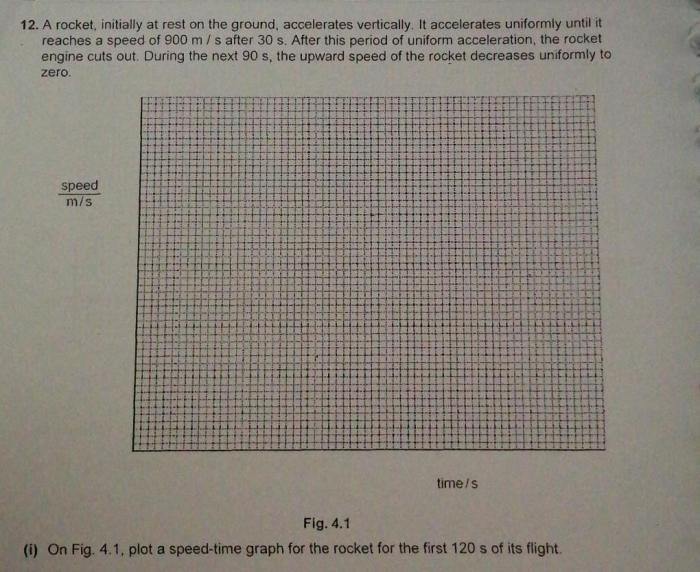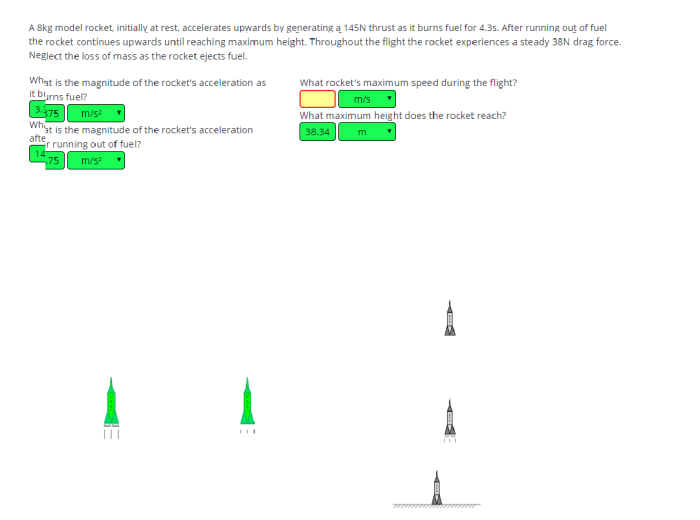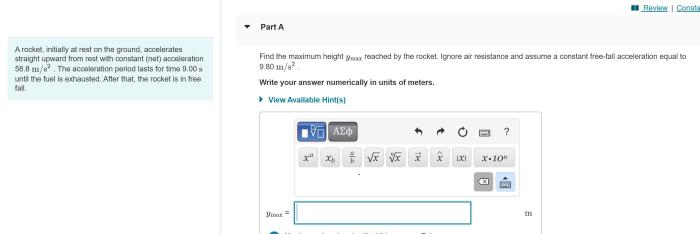A rocket initially at rest on the ground accelerates vertically, embarking on a journey that defies gravity’s pull. This exploration delves into the intricacies of its motion, examining the interplay of forces that govern its ascent. From the initial ignition to the final stages of its trajectory, we unravel the factors that influence its acceleration, thrust, drag, mass, fuel consumption, payload capacity, and more.
A Rocket Initially at Rest on the Ground: A Rocket Initially At Rest On The Ground Accelerates Vertically

A rocket is initially at rest on the ground when its engines are ignited, producing thrust that propels it upward. At this point, the rocket is subject to several forces:
- Thrust:The upward force generated by the rocket’s engines.
- Gravity:The downward force of attraction between the rocket and the Earth.
- Air resistance (drag):The resistive force exerted by the surrounding air as the rocket moves through it.
Acceleration
Acceleration is the rate at which the rocket’s velocity changes over time. The rocket’s acceleration is determined by the net force acting on it, which is the vector sum of thrust, gravity, and drag. The equation for the rocket’s acceleration is:
$$a = \fracF_netm$$
where:
- $a$ is the acceleration (m/s²)
- $F_net$ is the net force acting on the rocket (N)
- $m$ is the mass of the rocket (kg)
Factors that affect the rocket’s acceleration include the thrust produced by its engines, the mass of the rocket, and the air resistance it encounters.
Vertical Motion, A rocket initially at rest on the ground accelerates vertically
The rocket’s vertical motion is governed by the laws of motion and gravity. As the rocket accelerates upward, its velocity increases and it gains altitude. The rocket’s vertical motion can be divided into several phases:
- Ascent:The phase where the rocket is accelerating upward.
- Apogee:The highest point reached by the rocket.
- Descent:The phase where the rocket is decelerating downward due to gravity.
The trajectory of the rocket’s vertical motion can be represented by a graph or diagram.
Thrust
Thrust is the force that propels the rocket forward. It is generated by the rocket’s engines, which expel propellant (usually fuel and oxidizer) at high velocity. The amount of thrust produced depends on the type of engine and the propellant used.
Types of thrust systems include:
- Solid rocket motors:Use solid propellant that burns rapidly to produce thrust.
- Liquid rocket engines:Use liquid propellants that are pumped into the engine and mixed before combustion.
- Hybrid rocket motors:Use a combination of solid and liquid propellants.
Factors that affect the rocket’s thrust include the propellant used, the efficiency of the engine, and the nozzle design.
Query Resolution
What is the significance of thrust in rocket acceleration?
Thrust is the primary force that propels the rocket forward. It overcomes the forces of gravity and drag, enabling the rocket to ascend. The magnitude of thrust determines the rate of acceleration.
How does drag affect rocket motion?
Drag is a resistive force that opposes the rocket’s motion. It arises due to the interaction between the rocket’s surface and the surrounding air. Drag reduces the rocket’s acceleration and limits its maximum velocity.
What is the role of mass in rocket acceleration?
Mass is a measure of the rocket’s inertia. A heavier rocket requires more thrust to accelerate at the same rate as a lighter rocket. Reducing mass is crucial for optimizing rocket performance and increasing payload capacity.


